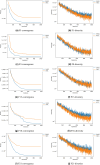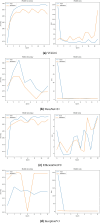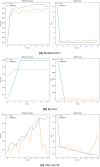Optimizing VGG16 deep learning model with enhanced hunger games search for logo classification
- PMID: 39738231
- PMCID: PMC11685449
- DOI: 10.1038/s41598-024-82022-5
Optimizing VGG16 deep learning model with enhanced hunger games search for logo classification
Abstract
Accurate classification of logos is a challenging task in image recognition due to variations in logo size, orientation, and background complexity. Deep learning models, such as VGG16, have demonstrated promising results in handling such tasks. However, their performance is highly dependent on optimal hyperparameter settings, whose fine-tuning is both labor-intensive and time-consuming. Swarm intelligence algorithms have been widely adopted to solve many highly nonlinear, multimodal problems and have succeeded significantly. The Hunger Games Search (HGS) is a recent swarm intelligence algorithm that has shown good performance across various applications. However, the standard HGS still faces limitations, such as restricted population diversity and a tendency to get trapped in local optima, which can hinder its effectiveness. In this paper, we propose an optimized deep learning architecture called EHGS-VGG16 designed based on the VGG16 model and boosted by an enhanced Hunger Games Search (EHGS) algorithm for hyperparameter tuning. The proposed enhancement to HGS involves modified search strategies, incorporating the concepts of "local best" and a "local escaping mechanism" to improve its exploration capability. To validate our approach, the evaluation is conducted in three folds. First, the EHGS algorithm is evaluated through 30 real-valued benchmark functions from the IEEE CEC2014 suite. Second, a custom-developed VGG16 model is tested on the Flickr-27 logo classification dataset and compared against state-of-the-art deep learning models such as ResNet50V2, InceptionV3, DenseNet121, EfficientNetB0, and MobileNetV2. Finally, EHGS is integrated into the VGG16 model to optimize its hyperparameters. The experimental results show that VGG16 outperformed the other counterparts with an accuracy of 0.956966, a precision of 0.957137, and a recall of 0.956966. Moreover, the integration of EHGS further improved classification quality by 3%. These findings highlight the potential of combining evolutionary optimization techniques with deep learning for enhanced accuracy in log classification tasks.
Keywords: Computer vision; Convolution neural network; Hunger games search; Hyperparameters; Logo classification; Metaheuristics.
© 2024. The Author(s).
Conflict of interest statement
Declarations. Competing interests: The authors declare no competing interests. Ethical statement: The manuscript has not been submitted to more than one journal for simultaneous consideration and has not been published elsewhere in any form or language.
Figures














Similar articles
-
Optimized deep learning architecture for brain tumor classification using improved Hunger Games Search Algorithm.Comput Biol Med. 2023 Jun;160:106966. doi: 10.1016/j.compbiomed.2023.106966. Epub 2023 Apr 24. Comput Biol Med. 2023. PMID: 37141655
-
An Enhanced Hunger Games Search Optimization with Application to Constrained Engineering Optimization Problems.Biomimetics (Basel). 2023 Sep 20;8(5):441. doi: 10.3390/biomimetics8050441. Biomimetics (Basel). 2023. PMID: 37754192 Free PMC article.
-
Improved sports image classification using deep neural network and novel tuna swarm optimization.Sci Rep. 2024 Jun 19;14(1):14121. doi: 10.1038/s41598-024-64826-7. Sci Rep. 2024. PMID: 38898134 Free PMC article.
-
Automated Monkeypox Skin Lesion Detection Using Deep Learning and Transfer Learning Techniques.Int J Environ Res Public Health. 2023 Mar 1;20(5):4422. doi: 10.3390/ijerph20054422. Int J Environ Res Public Health. 2023. PMID: 36901430 Free PMC article. Review.
-
Reinforcement learning using neural networks in estimating an optimal dynamic treatment regime in patients with sepsis.Comput Methods Programs Biomed. 2025 Jun;266:108754. doi: 10.1016/j.cmpb.2025.108754. Epub 2025 Apr 8. Comput Methods Programs Biomed. 2025. PMID: 40222267 Review.
Cited by
-
Artificial intelligence-driven cybersecurity system for internet of things using self-attention deep learning and metaheuristic algorithms.Sci Rep. 2025 Apr 16;15(1):13215. doi: 10.1038/s41598-025-98056-2. Sci Rep. 2025. PMID: 40240545 Free PMC article.
References
-
- Bacanin, N., Bezdan, T., Tuba, E., Strumberger, I. & Tuba, M. Optimizing convolutional neural network hyperparameters by enhanced swarm intelligence metaheuristics. Algorithms[SPACE]10.3390/a13030067 (2020).
-
- Attri, I., Awasthi, L. K., Sharma, T. P. & Rathee, P. A review of deep learning techniques used in agriculture. Eco. Inform.77, 102217. 10.1016/j.ecoinf.2023.102217 (2023).
-
- Jain, A., Ross, A. & Prabhakar, S. An introduction to biometric recognition. IEEE Trans. Circuits Syst. Video Technol.14, 4–20. 10.1109/TCSVT.2003.818349 (2004).
-
- Litjens, G. et al. A survey on deep learning in medical image analysis. Med. Image Anal.42, 60–88. 10.1016/j.media.2017.07.005 (2017). - PubMed
-
- Fehérvái, I. & Appalaraju, S. Scalable logo recognition using proxies. In 2019 IEEE Winter Conference on Applications of Computer Vision (WACV), 715–725 (2019). 10.1109/WACV.2019.00081
Publication types
MeSH terms
Grants and funding
LinkOut - more resources
Full Text Sources

